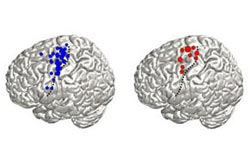Mapping the Brain

The brain mapping method developed in Freiburg allows scientists to attribute arm and leg movements (blue and red dots, respectively) to locations on the brain’s surface (Image: Tonio Ball). <br>
Whether we run to catch a bus or reach for a pen: Activities that involve the use of muscles are related to very specific areas in the brain. Traditionally, their exact location has only been determined through electrical stimulation or unnatural, experimental tasks. A team of scientists in Freiburg has now succeeded for the first time in mapping the brain’s surface using measurements of everyday movements.
Attributing abilities to specific brain regions and identifying pathological areas is especially important in the treatment of epilepsy patients, as severe cases require removal of neural tissue. Until now, such “mapping” involved stimulating individual regions of the brain’s surface with electric currents and observing the reaction or sensation. Alternatively, patients were asked to perform the same movements again and again until the physicians isolated the corresponding patterns in brain activity.
However, these methods required for the patient to cooperate and to provide detailed answers to the physicians’ questions. This is a prerequisite that small children or patients with impaired mental abilities can hardly meet, and hence there is a need for other strategies.
Scientists from the group of Dr. Tonio Ball at the Cluster of Excellence “BrainLinks-BrainTools” and the Bernstein Center Freiburg report in the current issue of NeuroImage that the brain’s natural activity during everyday movements can also be used to reliably identify the regions responsible for arm and leg movements.
The researchers examined data from epilepsy patients who had electrodes implanted under their skull prior to surgery. Using video recordings, the team captured the spontaneous movements of their patients, searching for concurrent signals of a certain frequency in the data gathered on the surface of the brain. They succeeded in creating a map of the brain’s surface for arm and leg movements that is as accurate as those created through established experimental methods.
A big hope for the team of researchers is also to gain new insights into the control of movements in the brain, as their method allows them to explore all manner of behaviors and is no longer limited to experimental conditions. Last but not least, the scientists explain that this new method of analyzing signals from the brain will contribute to the development of brain-machine interfaces that are suitable for daily use.
Original article
Ruescher J., Iljina O., Altenmueller D.-M., Aertsen A., Schulze-Bonhage A., Ball, T. (2013) Somatotopic mapping of natural upper- and lower-extremity movements and speech production with high gamma electrocorticography. NeuroImage 81, 164–177.
Contact:
Dr. Gunnar Grah
Science Communicator for BrainLinks-BrainTools
and Bernstein Center Freiburg
Phone: +49 (0)761/203 – 67722
E-Mail: grah@brainlinks-braintools.uni-freiburg.de
Media Contact
More Information:
http://www.uni-freiburg.deAll latest news from the category: Information Technology
Here you can find a summary of innovations in the fields of information and data processing and up-to-date developments on IT equipment and hardware.
This area covers topics such as IT services, IT architectures, IT management and telecommunications.
Newest articles

Bringing bio-inspired robots to life
Nebraska researcher Eric Markvicka gets NSF CAREER Award to pursue manufacture of novel materials for soft robotics and stretchable electronics. Engineers are increasingly eager to develop robots that mimic the…

Bella moths use poison to attract mates
Scientists are closer to finding out how. Pyrrolizidine alkaloids are as bitter and toxic as they are hard to pronounce. They’re produced by several different types of plants and are…

AI tool creates ‘synthetic’ images of cells
…for enhanced microscopy analysis. Observing individual cells through microscopes can reveal a range of important cell biological phenomena that frequently play a role in human diseases, but the process of…





















